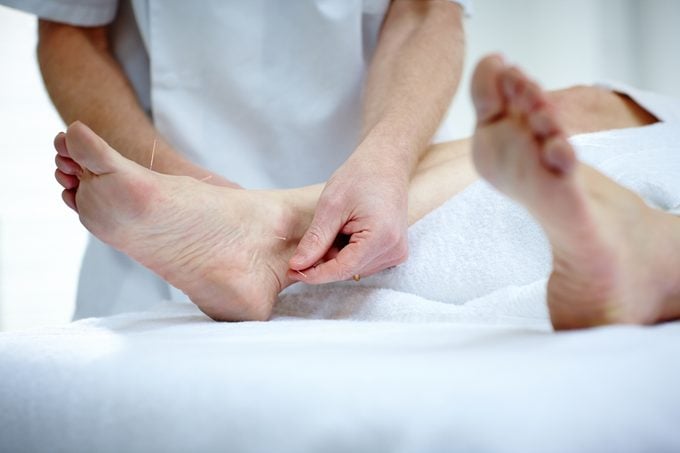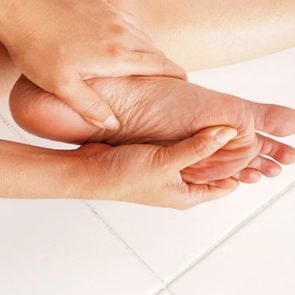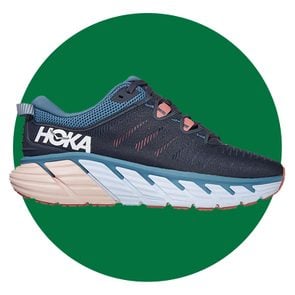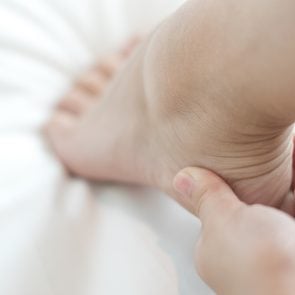What to Know About Acupuncture for Plantar Fasciitis
Updated: Jun. 28, 2021
Acupuncture may help plantar fasciitis, a common cause of heel pain. Here's how it works, the cost, the potential risks and benefits, and what to expect in a session.
What is plantar fasciitis?
You open your eyes, swing your legs over the edge of the bed, and take your first steps of the day, only to be greeted with searing heel pain. If this describes your typical morning, there’s a better than average chance you have plantar fasciitis because it’s the most common cause of heel pain.
Up to two million people seek treatment for it each year, and it’s estimated that one in 10 adults will experience plantar fasciitis in their lifetime, according to the Clinical Journal of Sport Medicine.
Plantar fasciitis is an inflammation or irritation of the plantar fascia—a thick band of tissue that runs along the sole of your foot, connecting your heel to the base of your toes, and supporting your arch. The fascia also acts as a kind of a shock absorber, but when it’s repeatedly stressed, the fascia can become bruised, swollen, or torn.
“The swelling pushes on structures like nerves, tendons, and ligaments, not to mention the plantar fascia,” and can lead to considerable pain, explains Ernest Luczkowski, DPM and podiatric surgeon at Advocate Aurora Health in the Greater Milwaukee area.
Most people experience the pain of plantar fasciitis when they first set their feet on the floor in the morning, or after a period of inactivity. Often, it improves as they begin to walk around during the day, only to worsen again by evening.
Here’s everything you need to know about plantar fasciitis, how it’s typically treated, and using acupuncture for plantar fasciitis.
Who gets plantar fasciitis?
Anyone who spends a lot of time on their feet is at risk for developing plantar fasciitis. “The irritation starting point is not completely understood,” says Dr. Luczkowski, but it appears to result from a combination of factors, he says.
Athletes are particularly susceptible, especially if their exercise regimen includes high-impact activities, like running on hard surfaces or uneven terrain. Sudden increases in the frequency or intensity of exercise can also lead to plantar fasciitis.
“If you’re constantly pounding on [the fascia], it becomes almost like a repetitive stress injury,” says Betty Liu, MD, an associate professor at the University of Pittsburgh School of Medicine, who performs acupuncture in her medical practice.
People with very tight calves and those with either flat feet or very high arches are also at risk for developing plantar fasciitis, as are people who are overweight or over 40. The wrong footwear can also play a role. (These are the best shoes for plantar fasciitis.)
How is plantar fasciitis typically treated?
Typically, podiatrists and family physicians who see people for plantar fasciitis rely on some combination of treatments. According to Dr. Luczkowski, these usually include:
- Physical therapy (including stretching, icing, and gait training)
- Anti-inflammatory medications
- Changing or reducing activity to eliminate mechanical stress on the foot
- Changing to more supportive footwear, possibly including custom orthotics
- Steroid injections
(Keep these plantar fasciitis stretches handy.)
In addition to these common approaches, other treatments may include:
- Night splints to stretch the fascia while sleeping
- Shockwave therapy
- Platelet-rich plasma injections
- Surgery, either to lengthen the calf muscles or to release the plantar fascia
Though plantar fasciitis often resolves on its own, many people find plantar fasciitis to be painfully persistent, despite this toolbox of available treatments.
Some people turn to alternative and complementary therapies, including acupuncture, for pain relief—often after exhausting all other nonsurgical treatments, like acupuncture.
How does acupuncture work?
Acupuncture is a form of traditional Chinese medicine (TCM), in which very fine needles are gently inserted into specific points in the body to relieve pain or otherwise promote healing.
Some practitioners enhance their treatments by sending very mild currents of electrical stimulation through the needles (a practice called electro-acupuncture). Some also use Chinese herbs along with needle placement.
Typically, someone with “licensed acupuncturist” credentials (LAc) after their name will perform acupuncture. In recent years, however, some physicians and chiropractors have sought additional training and board certification in the practice, and now perform acupuncture in their offices.
Another technique, called “dry needling,” often performed by physical therapists, is similar but needles are inserted into muscular trigger points (often felt as “knots”) rather than energetic channels. The needles cause the muscles to twitch and then finally relax.

Acupuncture for plantar fasciitis
Very few, if any, randomized controlled trials have been conducted on acupuncture specifically as it relates to plantar fasciitis.
In one small but seminal randomized controlled trial published in the journal Evidence-Based Complementary and Alternative Medicine, researchers divided 53 patients into two groups to determine how well acupuncture reduced pain from plantar fasciitis.
The treatment group received needling at a point believed to be specific for heel pain relief, while the control group had needles inserted at a point believed to be responsible for general pain relief. Both groups received “treatment” five times a week for two weeks and reported their perception of heel pain each morning using a 100-point scale.
One month later, patients in the treatment group reported lower pain scores than those in the control group. The researchers concluded that acupuncture using the specific point for heel pain was effective.
Other published research consists primarily of systematic reviews of earlier studies. While these reviews don’t produce new results, they can be useful in gathering and summarizing the body of knowledge available about acupuncture.
At least five such reviews have been conducted between 2012 and 2019, with mixed results. One 2017 review published in Singapore Medical Journal found that acupuncture was effective in reducing plantar fasciitis pain for up to eight weeks, but not longer.
Another study, published in 2017 in International Orthopaedics found that dry needling was more effective than steroids in reducing plantar fasciitis pain in the long term (more than 12 months after treatment).
Meanwhile, a 2018 study in the Journal of Bodywork and Movement Therapies found dry needling to be at least as effective as placebo treatments, steroids, platelet-rich plasma, and Botox injections.
Risks or side effects
Minor side effects can occur with acupuncture, such as pain, bruising, or bleeding near the needle insertion site. Less commonly, people may feel dizzy or faint. Rare side effects include internal bleeding or damage to an internal organ, nerve damage, and convulsions.
Certain people, such as those with a known bleeding disorder, may be at heightened risk for complications. People with implanted pacemakers should think twice before having acupuncture with electrical stimulation, as it can cause the pacemaker to malfunction, according to a study in Acupuncture in Medicine.
Talk with your doctor before starting acupuncture to make sure it’s the best choice for you.
Your first acupuncture session
If you decide to give it a try, you should expect a clinical experience. The doctor or acupuncturist will start by taking a detailed medical history to rule out any contraindications to treatment.
“Not only do I look at the patient’s body as a whole and treat them uniquely, but I also take into consideration their lifestyle and how they interact with their environment,” says Emily Grace Siy, licensed acupuncturist. “When it comes to plantar fasciitis, that means also looking at footwear, how they walk, and how often they walk.”
After the medical history and exam, you will be asked to lie down on a treatment table or sit in a chair, fully clothed. Your practitioner will then place several needles in your foot and lower leg, and possibly other areas, depending on your specific situation.
The acupuncturist may angle, twirl or otherwise manipulate the needles. Then you will be asked to remain still for anywhere from 20 minutes to an hour while the needles do their work.
You’ll probably be asked to commit to one or two sessions a week for three to five weeks, and should start to see a difference within a week or two.
How much does it cost?
Typically, the first consultation is more expensive, landing between $100 and $300. For subsequent sessions, rates are usually around $50-$100 per session but may cost more in large metropolitan areas.
Increasingly, however, acupuncture is being covered by medical insurance, though sometimes only for specific conditions, like low back pain, or with certain types of providers. If your insurance carrier doesn’t cover acupuncture for plantar fasciitis, there are still ways to reduce the cost.
Some clinics perform “community acupuncture,” where treatments are done in a group setting or use a sliding fee scale. You may also be able to purchase a package of several sessions at a discounted rate.
How to find an acupuncturist
“The best way to find an acupuncturist is by referral,” says Siy, to ensure you find a comfortable match. Barring that, she says, the National Certification Commission for Acupuncture and Oriental Medicine (NCCAOM) has a directory of practitioners. So does the American Board of Chiropractic Acupuncture.
While the evidence is inconclusive, and the studies that support the use of acupuncture have been small, many experts agree that the risk-benefit ratio is promising.
“I think the conclusion is, it doesn’t hurt to try,” says Dr. Liu.
Even Dr. Luczkowski, who leans toward treatments with more scientific evidence behind them, largely agrees. He says that if a patient insists on trying acupuncture for plantar fasciitis, he won’t stand in their way.
“Ultimately, if it did work and my patient was not harmed, then how they get better matters very little. We may just need to see the science to have it become standard; we also may always see it as inconclusive. But it’s much better to give something a try if it makes any patient’s reality and life healthier and happier,” says Dr. Luczkowski.
For that reason, Dr. Liu recommends not using acupuncture as the treatment of last resort.
“Usually acupuncture is better for more acute situations versus those that are more chronic, or after several surgeries.” Instead, she says, “I would suggest using it as an adjunct or complement to everything else you’re doing.”
Next, these are the foot symptoms that can reveal disease.














